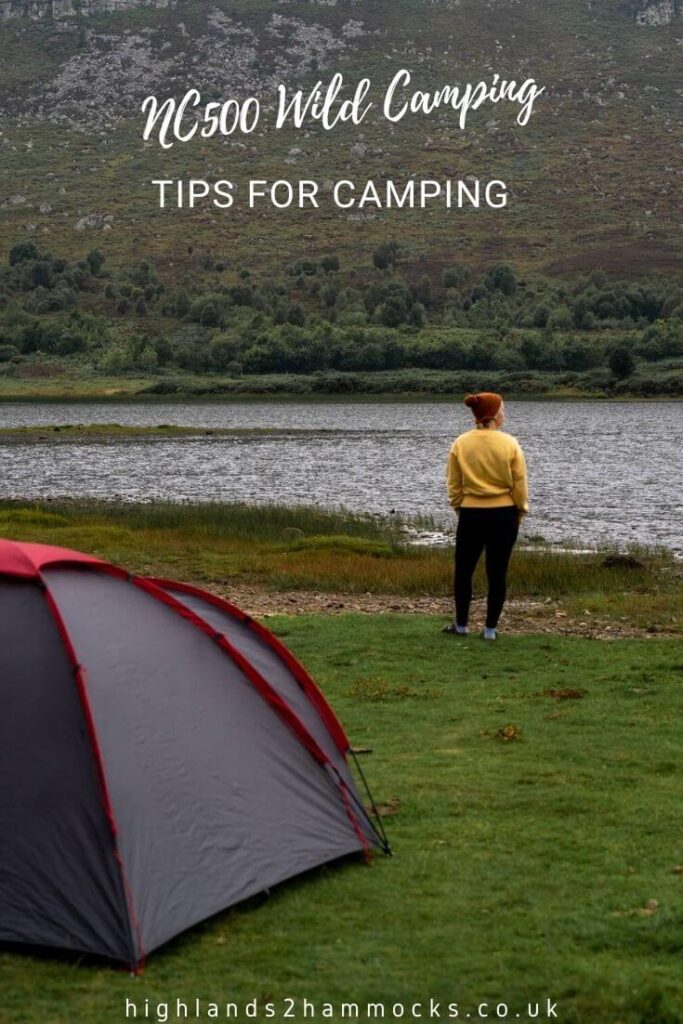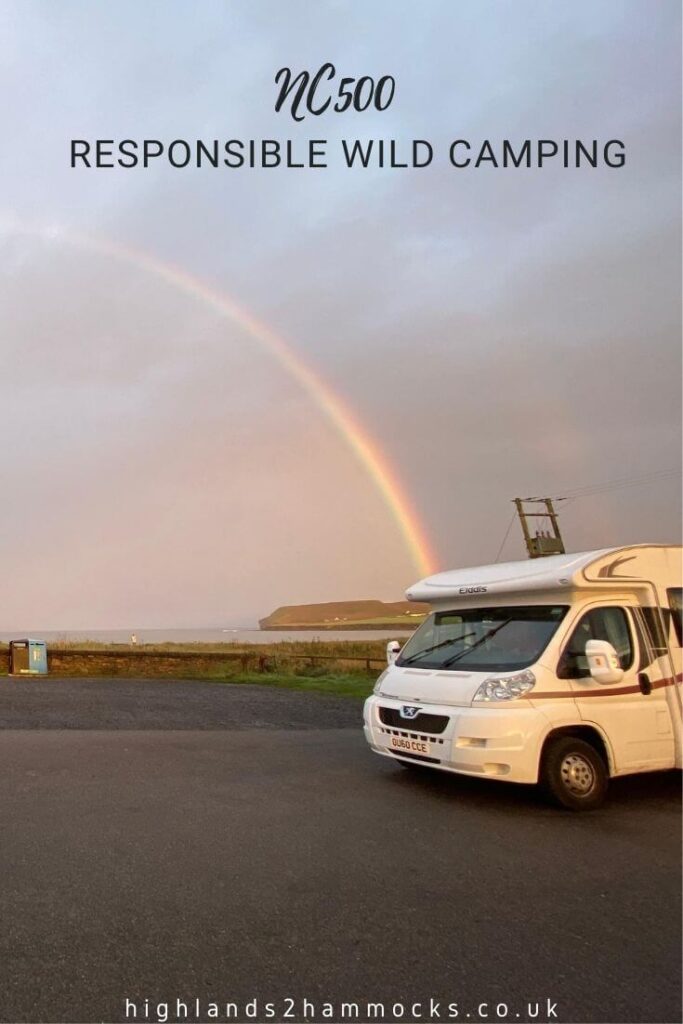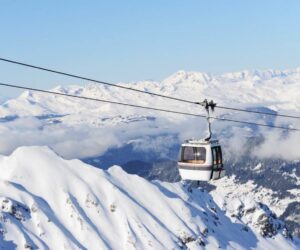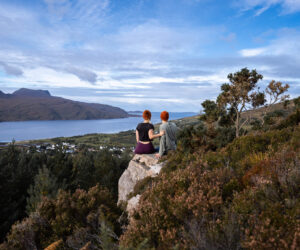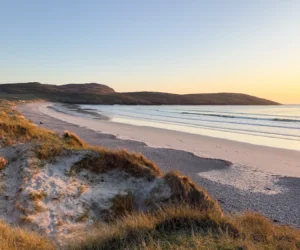The North Coast 500 is one of the most spectacular road trips in Scotland. With beautiful white sandy beaches and magnificent historical castles, why would you not want to visit this amazing part of the country.
With that being said, the infrastructure around the north coast of Scotland, is not built for the number of visitors it receives as it becomes more and more popular. Therefore it is important that when we do visit this part of Scotland, we treat it with respect and keep it tidy and free from damage.
In this guide we will discuss how to wild camp responsibly around the NC500, sharing our best tips.
No time to read now? No problem, save a pin to your Pinterest board for later!
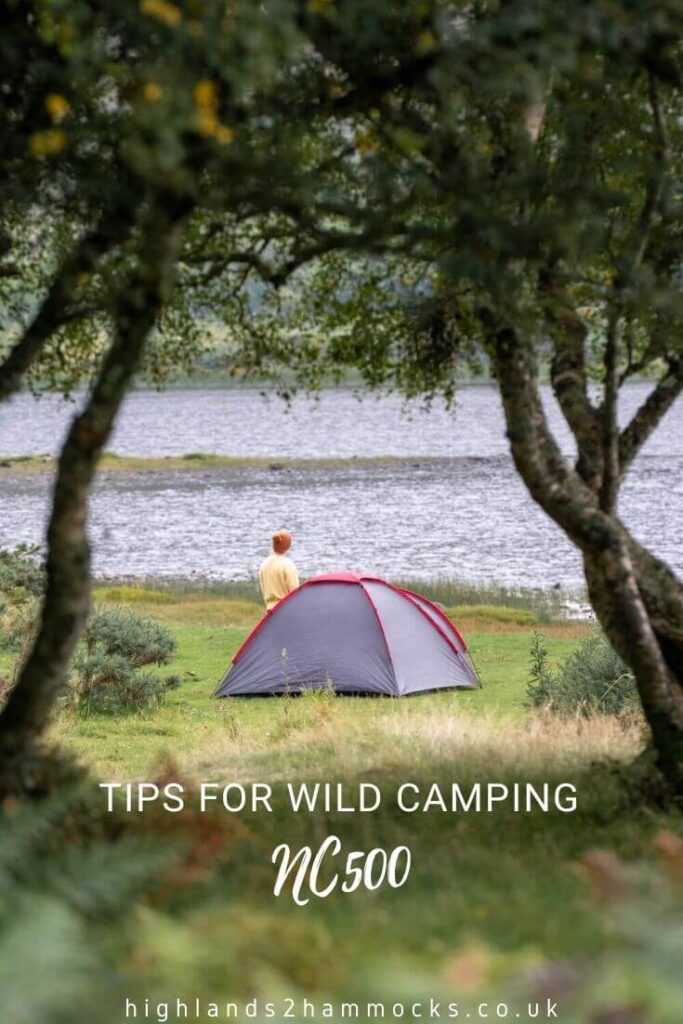
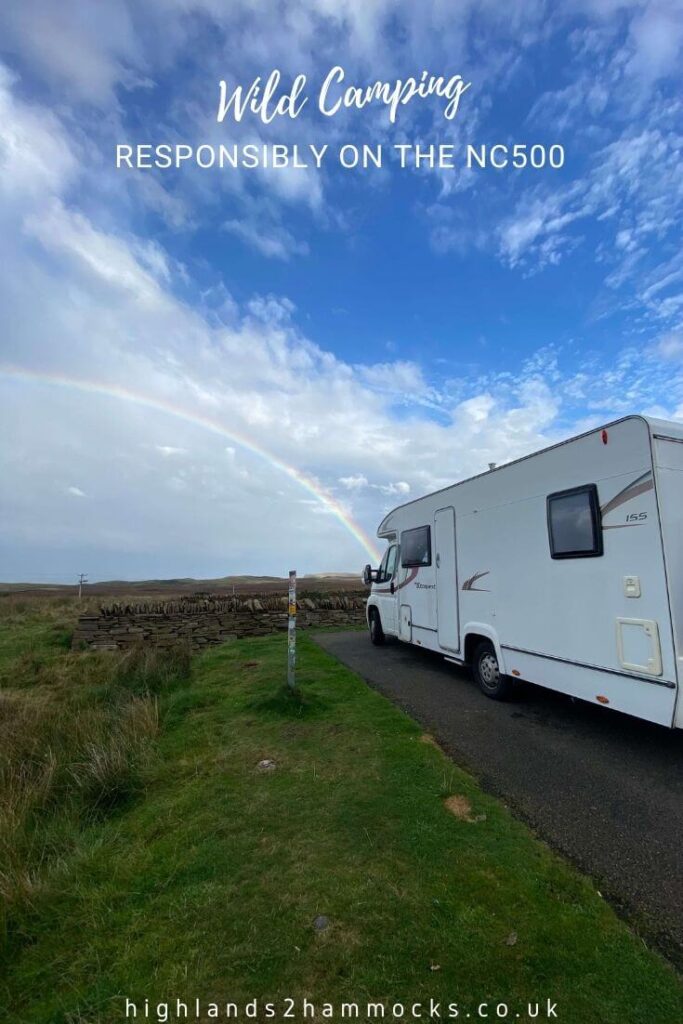
Destination North Coast Map
Make sure you have all the resources you need to make the most of your trip to the North Coast of Scotland. Our Destination North Coast Map is the perfect addition to any traveller’s toolkit. With detailed information on all the best spots, along the NC500, this map is your ultimate guide to exploring the rugged beauty of Scotland’s north coast.

Must Read Tips for Responsible NC500 Wild Camping
As much as staying at a campsite on the NC500 may feel more luxurious, wild camping around the NC500 is a magical experience. The views you can camp up with will be like no other. However, we must ensure we take steps to protect this right we have in Scotland and protect the nature we camp on. In this guide, we will discuss the following points in more detail, to ensure we can all enjoy the NC500 road trip.
Table of Contents
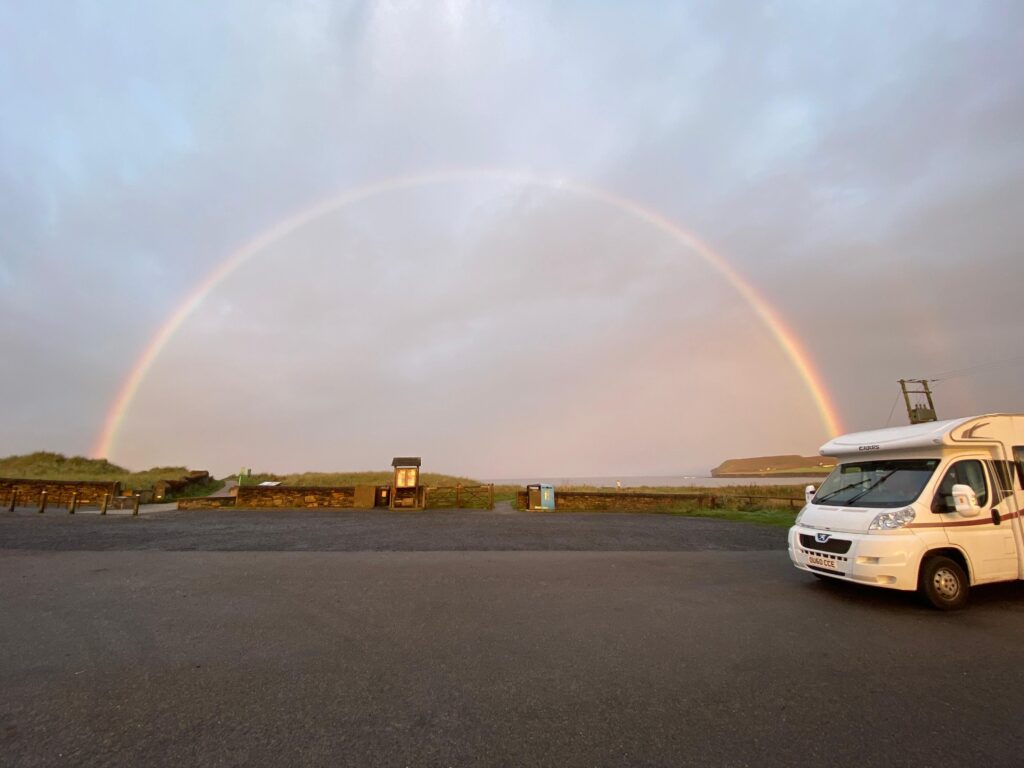
Planning Your Trip
We use the below booking platforms to plan our trips. We hope you find them useful too!
NC500 Motorhome and Campervan Scheme
The NC500 Motorhome Scheme, officially known as the Highland Campervan and Motorhome Scheme, was launched by the Highland Council on July 1, 2024. This innovative initiative is designed to address the growing number of motorhomes and campervans traveling along the popular North Coast 500 (NC500) route, ensuring that their impact on the local environment and communities is managed sustainably.
The scheme offers a voluntary seven-day pass costing £40, inclusive of VAT. This pass grants motorhome and campervan users access to 12 designated overnight parking locations along the NC500 route, including scenic spots like Torvean Car Park in Inverness, Nairn Harbour, Dunnet Head Car Park, and Ullapool Latheron Car Park.
These parking spots are available on a first-come, first-served basis from 10 PM to 8 AM, with a 72-hour no-return policy at each location. This ensures that the facilities are used responsibly and that a larger number of travellers can benefit from them.
Overall, the NC500 Motorhome Scheme provides a structured and sustainable approach to motorhome travel in one of Scotland’s most scenic and popular areas. We think this is a great idea and encourage everyone to take advantage of it if you are looking to explore this road trip soon.
Read all about this new scheme in our complete guide to the NC500 Motorhome Scheme here.
For more information or to purchase a membership, travellers can visit the Highland Council’s official website.
Respect the Locals
Think about where you are going to camp when you are looking for a spot and make sure you are not pitching up right outside someone’s house. Respect those who live in the area and keep the noise to a minimum. Observe the local guidance in place, if it states no overnight camping, you are best to find another spot to pitch up for the night.
By following this guidance we can still support small local towns and admire the beauty of Scotland without upsetting those who live there.

Leave no Trace
When you leave a camping spot, make sure you take all your rubbish with you to dispose of in a bin and leave no evidence of you having been there. This includes any human waste. Any human waste should be buried and done away from any water source.
Take a bin bag with you to your camp spot to remind you to dispose of your rubbish and make it easier for you to carry it to a bin.
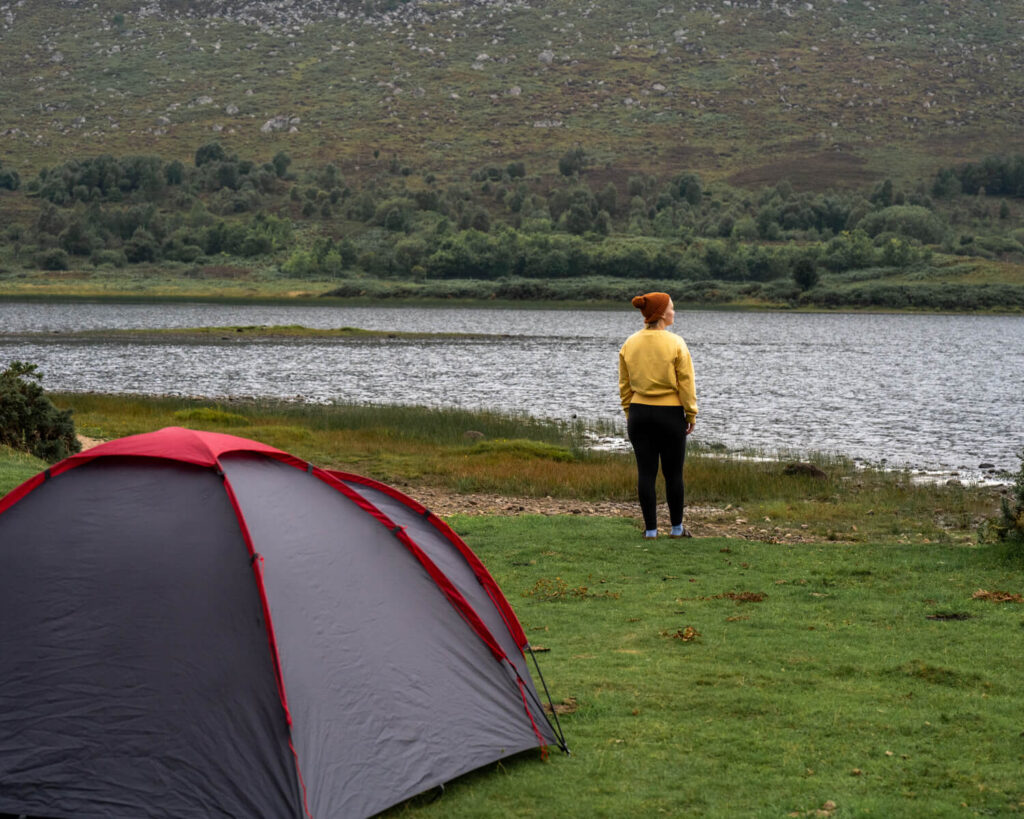
DON’T FORGET
Your trip to Scotland will be a lot more comfortable with a midge net and midge spray. These little biting bugs can be enough to ruin a trip if you don’t have the equipment to protect yourself from them. A repelling candle can also be helpful if you are sitting oustide.
Be a Responsible Wild Toiletter
We’ve all got to go when we need to go and there may not always be toilet facilities in the area. If you need the toilet, find somewhere discreet to perform your duties at least 30m away from any water. You should also carry a trowel to bury the results. Remember, leave no trace. If you have sanitary products, you will need to dispose of these in a bin instead of burying them.
Ensure that any toilet paper is either buried or disposed of in a bin bag so that it doesn’t end up blowing around in the wind or spoiling the area.
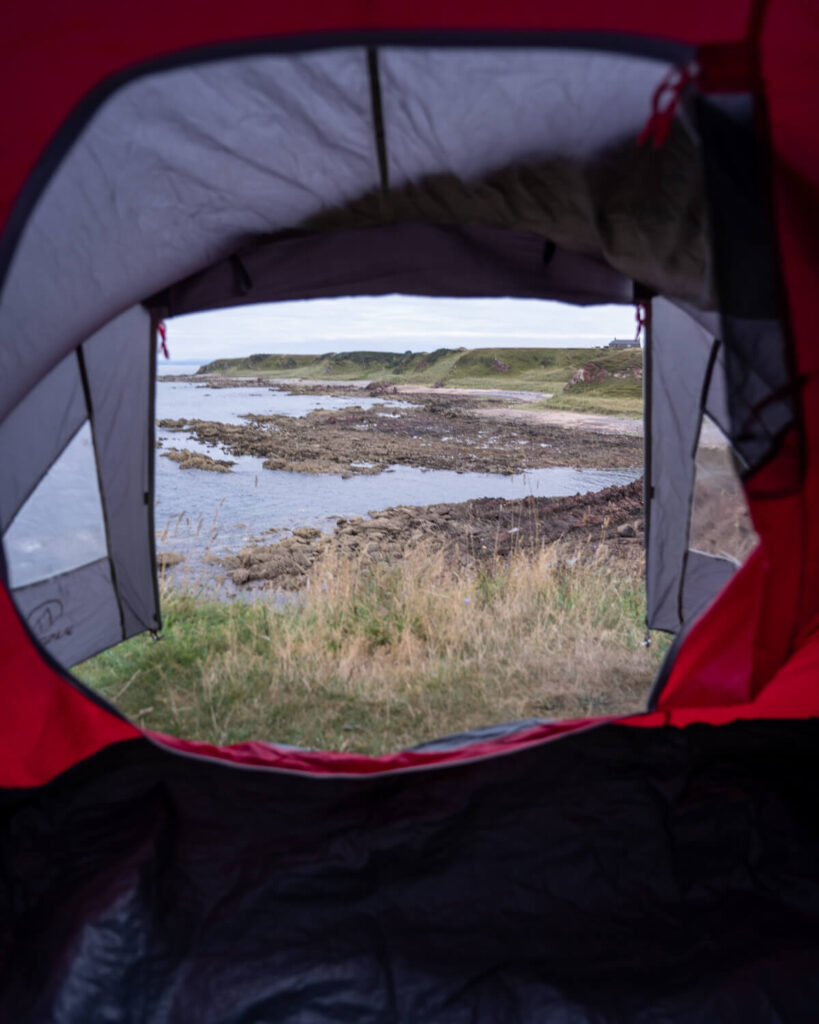
Struggling to plan your North Coast 500 road trip?!
Don’t Overstay Your Welcome
We tend to go by the rule arrive after dark and leave before light however in the Scottish summer on the north coast, that is very difficult to do. Depending on the place you are choosing to camp, we would advise not setting up camp and spreading yourself out in one place all day.
It is common practice that tents aren’t left up during the day and that we should only stay in the one spot for one night at a time.

Keep your Group Small
Avoid travelling or camping in large groups. If you are wild camping, keep your group to a maximum of 2 tents. It is also preferred that tents are small and don’t take up a large surface area to avoid any unnecessary damage to the ground underneath.
We would also suggest that you avoid the crowds. If you arrive late to a camp spot and it is already really busy, find your own remote spot elsewhere and don’t add to the crowds.

Help to Protect the Environment at all times
We all love a barbecue however they can really ruin the ground beneath. If you have a barbecue, make sure it is on a raised platform and that it is not anywhere near dry grass or anything that could catch light and cause a fire.
Having a camp fire can also damage the ground and put the area at risk of a fire if it is a dry summer.
There is a lot of wildlife roaming free around the north coast of Scotland. If you have a dog, be a responsible owner and keep your dog on a lead in areas where there are wild animals.
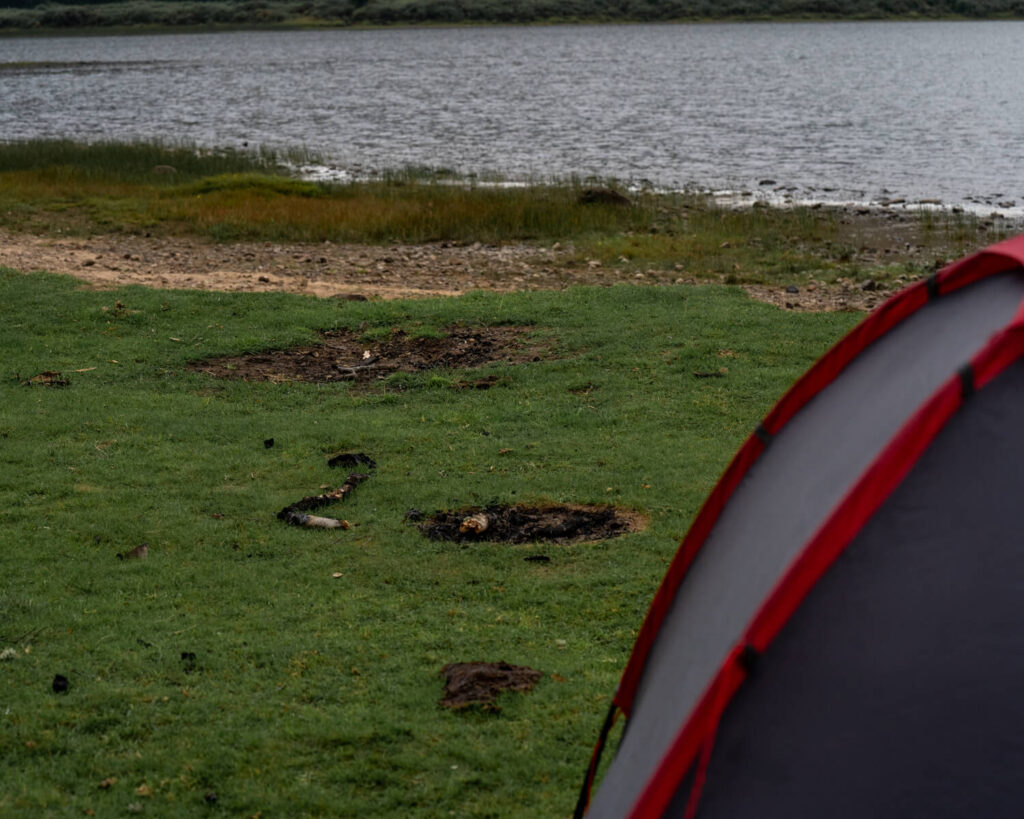
Before You Leave on the North Coast 500
Before you head off on your trip around the NC500, there are certain things you will need to get organised to ensure a smooth trip. These include how to get around the route, including being aware of single track roads, etc., what to pack for Scotland, where to stay along the route and what travel insurance to book.
Read more planning tips for the North Coast 500 in our full guide.
How Do I Get Around the NC500?
Given the remote location of the NC500 and the majority of the sights along the route, the best way to get around this road trip is by driving. There are of course other methods that are still popular, such as cycling and hiking, however, if you have a short amount of time on the route, neither of these are very suitable.
As for public transport, the use around the NC500 is understandably difficult due to how remote each location is, however, with the increasing problem of congestion along the route, this is a good option to research if you have time. If it is something that interests you, you can read a public formed itinerary of how to get around the NC500 by public transport over here.
If you are looking to rent a cosy, reliable and luxurious campervan for your trip along the NC500, we recommend hiring through Spaceships Rentals.
Browse the full range of vehicles on offer at Spaceships over here.
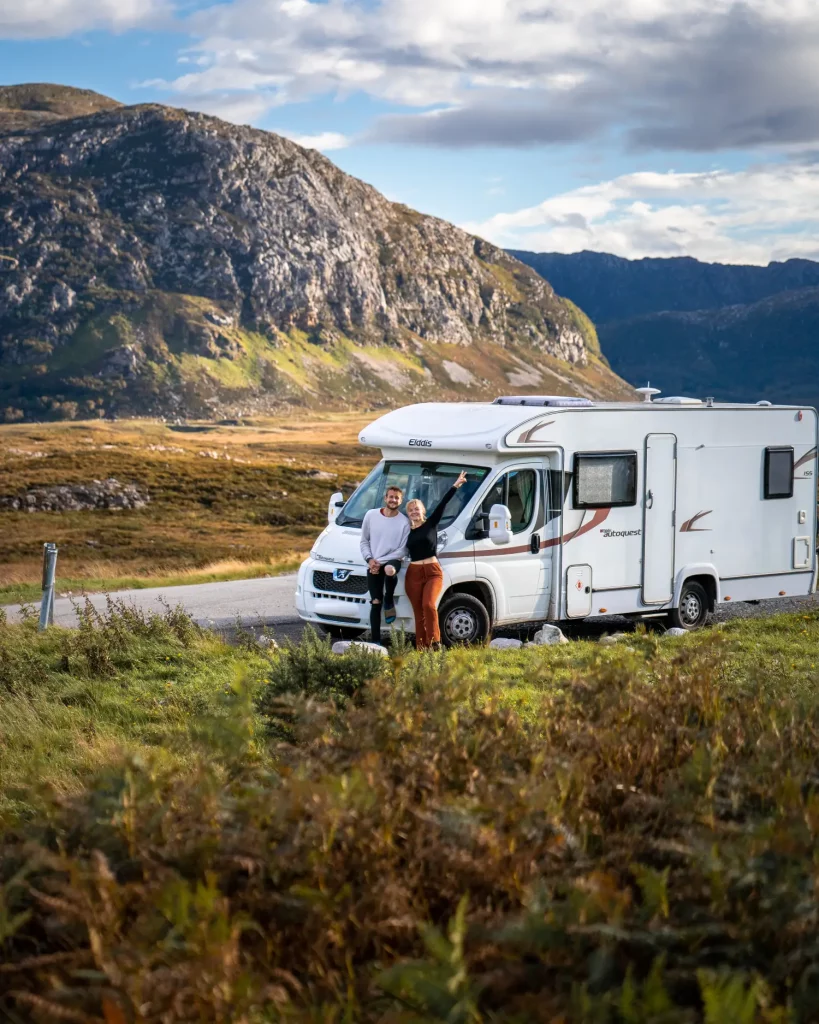
What Should I Pack for the NC500?
When it comes to packing for a trip along the NC500 there is one item of clothing that you are going to need all year round: a waterproof. It rains in Scotland on average 250 days a year, meaning that during your 7-day NC500 road trip you will probably experience at least a drizzle of rain. Due to this, the number one item on any Scotland packing list is a good waterproof jacket.
As for the rest of the year, the temperature in Scotland and the central heartlands is reasonably mild for most of the year. During the winter months, you will most likely experience snow, however, temperatures usually sit around freezing, so it is not too cold. For your reference, the average temperatures in Scotland are listed below during each season.
Spring (March, April, May) – 5-10 degrees C
Summer (June, July, August) – 15 degrees C
Autumn (September, October, November) – 5-10 degrees C
Winter (December, January, February) – 0-5 degrees C
As you can see, the weather never really gets above the teens, with anything over 25 degrees C considered a heatwave. The best way to pack for your trip to the highlands is with layers that can be added and removed as you need them. You will definitely need a hat and gloves during the colder months and will most likely need sunscreen to protect you on the long days in the open.
It is also important to stay hydrated, especially when you are out exploring in the marvellous landscape of Scotland. We use Water to Go water bottles to fill up with water from running streams when we are hiking.
Given the beautiful sights and scenery that you are no doubt going to see around Scotland, we highly recommend packing a good camera for your trip. If you want to read more about the cameras we use and why we love them, check out the link below.
Photography Equipment
Main Photography Camera – Sony A7v Mirrorless Camera and Sony A7iii Mirrorless Camera
Microphone – Sony Mic ECM-B1M
Main Lens – Tamron 17-28mm f/2.8
Zoom Lens – Tamron 70-180mm f/2.8
Camera Tripod – ZOMEI Z669C Camera Tripod
Gorilla Pod – JOBY JB01507-BWW GorillaPod
Action Camera – GoPro Hero 11 and Insta 360 One RS
Drone Camera – DJI Mavic Pro 3
Camera Bag – Wandrd PRVKE 41L and The Nest by Tropicfeel
Phone Tripod – Manfrotto MKPIXICLAMP-BK, Mini Tripod with Universal Smartphone Clamp
Sturdy Phone Tripod & Selfie Stick – ATUMTEK 61″ Selfie Stick Tripod, Sturdy Phone Tripod Stand with Wireless Remote
Hard Drives – LaCie Rugged Mini, 5TB, 2.5″, Portable External Hard Drive
SSD – SanDisk Extreme Pro 1TB Portable NVMe SSD
Travel Adapter –Worldwide Travel Adapter Universal Travel Plug with 4 USB Ports+Universal AC Socke
Where Should I Stay on the NC500?
The remoteness in the highlands of Scotland will leave you with little choice of accommodation in each location along the NC500, however, there are still enough options to choose from to ensure a comfortable trip. These are mostly in the shape of B&Bs, Airbnbs, converted cottages and other quirky accommodations.
Depending on how adventurous you are, there may be more accommodation choices than just the above, often with an even better view. Caravan and camping sites are abundant along the NC500, drawing camping enthusiasts from all over the world. For some of the most spectacular bedside scenery along the North Coast 500, we recommend packing a tent and getting in touch with nature for the week.
As we travelled along the North Coast 500, camped in our trusty Vango tent on a mixture of campsites and wild sites. Wild camping is a fantastic way to enjoy the beauty of the highlands, however, it must be done respectfully. Read our full guide to Wild Camping if you wish to give it a go so you know everything you need to for a comfortable and sustainable trip.
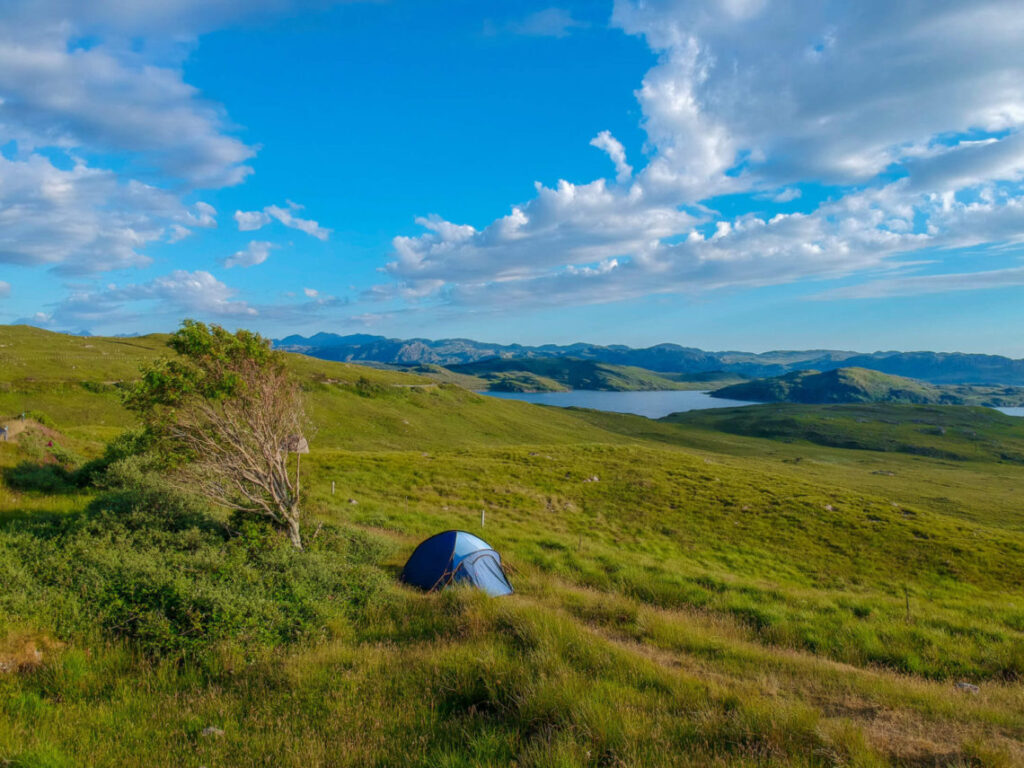
What is the Best Travel Insurance?
I know travel insurance is the least enjoyable thing to purchase and look at when you’re planning a trip, however, you wouldn’t want to be without it in the event that something happened. Accidents can happen anywhere and the extortionate medical bills will ruin your trip if you are not covered.
To ensure you have a stress-free trip with no worries about potential medical bills, make sure you cover yourself when you travel. We can recommend using SafetyWing, a backpacker-friendly and cheap insurance company that provides good coverage and support. It is also nomad-friendly, unlike most other insurance companies, meaning you do not need to worry about being out of your home country for too long.
Get a quote for your travel insurance right here and get covered!
So there you have it, tips on how to wild camp responsibly around the NC500. If you have visited the NC500 recently, let us know what you thought about it or if you have any suggestions for things to do, let us know in the comments below.
As always, sharing is caring so make sure to share this photo guide with your family and friends and inspire them to head off on their own North Coast 500 adventure. If you are planning the trip for yourself, make sure you have a look at the rest of our Scotland content for more inspiration to our beautiful home country.
When you set off on your own adventure, be sure to tag us in your photos on Instagram and we will share them with the rest of our community. In the meantime, why not follow us over there to see what we are currently up to and keep up with us on our Instagram Stories.
Now Read:
- Wild Camping North Coast 500 – The 10 Best Places to Wild Camp
- North Coast 500 Packing Guide – What You Will Need for the NC500
- 7-day North Coast 500 Itinerary – FREE, Detailed and Unforgettable!
This article may contain affiliate links that provide us with a small income. For more information read our Affiliate page.
Pin this image to your Scotland Pinterest board for later
